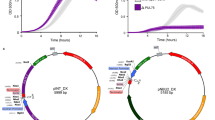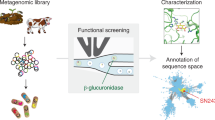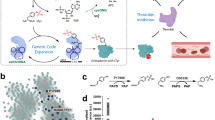Abstract
The use of the Escherichia coli enzyme β-glucuronidase (GUS) as a reporter in gene expression studies is limited due to loss of activity during tissue fixation by glutaraldehyde or formaldehyde. We have directed the evolution of a GUS variant that is significantly more resistant to both glutaraldehyde and formaldehyde than the wild-type enzyme. A variant with eight amino acid changes was isolated after three rounds of mutation, DNA shuffling, and screening. Surprisingly, although glutaraldehyde is known to modify and cross-link free amines, only one lysine residue was mutated. Instead, amino acid changes generally occurred near conserved lysines, implying that the surface chemistry of the enzyme was selected to either accept or avoid glutaraldehyde modifications that would normally have inhibited function. We have shown that the GUS variant can be used to trace cell lineages in Xenopus embryos under standard fixation conditions, allowing double staining when used in conjunction with other reporters.
This is a preview of subscription content, access via your institution
Access options
Subscribe to this journal
Receive 12 print issues and online access
$209.00 per year
only $17.42 per issue
Buy this article
- Purchase on Springer Link
- Instant access to full article PDF
Prices may be subject to local taxes which are calculated during checkout






Similar content being viewed by others
References
Jefferson, R.A., Burgess, S.M. & Hirsh, D. Beta-glucuronidase from Escherichia coli as a gene-fusion marker. Proc. Natl. Acad. Sci. USA 83, 8447–8451 (1986).
Martin, T., Woehner, R-V., Hummel, S., Willmitzer, L. & Frommer, W.B. in GUS Protocols: using the GUS gene as a reporter of gene expression. (ed. Gallagher, S.R.). 23–43 Academic Press, New York; 1992).
Naleway, J.J. in GUS Protocols: using the GUS gene as a reporter of gene expression. (ed. Gallagher, S.R.). 61–76 (Academic Press, New York; 1992).
Farrell, L.B. & Beachy, R.N. Manipulation of beta-glucuronidase for use as a reporter in vacuolar targeting studies. Plant Mol. Biol. 15, 821–825 (1990).
Craig, S., in GUS Protocols: using the GUS gene as a reporter of gene expression (ed. Gallagher, S.R.) 115–124 (Academic Press, New York; 1992).
Jefferson, R.A. The GUS reporter gene system. Nature 342, 837–838 (1989).
Habeeb, A.F.S.A. & Hiramoto, R. Reactions of proteins with glutaraldehyde. Arch. Biochem. Biophys. 126:16–26 (1968).
Schlaman, H.R., Risseeuw, E., Franke-van Dijk, M.E. & Hooykaas, PJ. Nucleotide sequence corrections of the uidA open reading frame encoding beta-glucuronidase. Gene 138, 259–260 (1994).
Oshima, A. et al. Cloning, sequencing, and expression of cDNA for human beta-glucuronidase. Proc. Natl. Acad. Sci. USA 84, 685–689 (1987).
D'Amore, M.A., Gallagher, P.M., Korfhagen, T.R. & Ganschow, R.E. The complete sequence and organization of the murine beta-glucuronidase gene. Biochemistry 27, 7131–7140 (1988).
Nishimura, Y. et al. Nucleotide sequence of rat preputial gland beta-glucuronidase cDNA and in vitro insertion of its encoded polypeptide into microsomal membranes. Proc. Natl. Acad. Sci. USA 83, 7292–7296 (1986).
Ray, J. et al. Cloning of canine beta-glucuronidase cDNA, mutation identification in canine MPS VII, and retroviral vector-mediated correction of MPS VII cells. Genomics 48, 248–253 (1988).
Zhang, J.H., Dawes, G. & Stemmer, W.P. Directed evolution of a fucosidase from a galactosidase by DNA shuffling and screening. Proc Natl Acad Sci USA 94, 4504–4509 (1997).
Giver, L., Gershenson, A., Freskgard, P.O. & Arnold, F.H. Directed evolution of a thermostable esterase. Proc. Natl. Acad. Sci. USA 95, 12809–12813 (1998).
Cadwell, R.C. & Joyce, G,F. Randomization of genes by PCR mutagenesis. PCR Methods Appl. 2, 28–33 (1992).
Blanco, C. & Nemoz, G. One step purification of Escherichia coli beta-glucuronidase. Biochimie 69, 157–161 (1987).
Stemmer, W.P.C. DNA shuffling by random fragmentation and reassembly: in vitro recombination for molecular evolution. Proc. Natl. Acad. Sci. USA 91:10747–10751 (1994).
Jain, S., Drendel, W.B., Chen, Z.W., Mathews, F.S., Sly, W.S. & Grubb, J.H. Structure of human beta-glucuronidase reveals candidate lysosomal targeting and active-site motifs. Nat. Struct. Biol. 3, 375–381 (1996).
Needleman, S.B. & Wunsch, C.D. A general method applicable to the search for similarities in the amino acid sequence of two proteins. J. Mol. Biol. 48, 443–453 (1970).
Kozak, M. An analysis of 5´-noncoding sequences from 699 vertebrate messenger RNAs. Nucleic Acids Res. 15, 8125–8148 (1987).
Moore, J.C. & Arnold, F.H. Directed evolution of a para-nitrobenzyl esterase for aqueous-organic solvents. Nat. Biotechnol. 14, 458–467 (1996).
Zhang, X.J., Baase, W.A., Shoichet, B.K., Wilson, K.P. & Matthews, B.W. Enhancement of protein stability by the combination of point mutations in T4 lysozyme is additive. Protein Eng. 8, 1017–1022 (1995).
Holm, L. & Sander, C. Mapping the protein universe. Science 273, 595–603 (1996).
van der Loos, C.M., Becker, A.E. & van den Oord, J.J. Practical suggestions for successful immunoenzyme double-staining experiments. Histochem. J. 25, 1–13 (1993).
Wallingford, J., Seufert, D., Virta, V. & Vize, P. p53 Activity is essential for normal development in Xenopus laevis. Curr. Biol. 7, 747–757 (1997).
Wallingford, J., Carroll, T. & Vize, P. Precocious expression of the Wilms' tumor gene xWT1 inhibits embryonic kidney development in Xenopus laevis. Dev. Biol. 202, 103–112 (1998).
Raz, E., Zlokarnik, G., Tsien, R.Y. & Driever, W. Beta-lactamase as a marker for gene expression in live zebrafish embryos. Dev. Biol. 203, 290–294 (1998).
Grimm, E. & Arbuthnot, P. Rapid purification of recombinant Taq DNA polymerase by freezing and high temperature thawing of bacterial expression cultures. Nucleic Acids Res. 23, 4518–4519 (1995).
King, P.V. & Blakesley, R.W. Optimizing DNA ligations for transformations. FOCUS 8, 30–32 (1986).
Inoue, H., Nojima, H. & Okayama, H. High efficiency transformation of Escherichia coli with plasmids. Gene 96, 23–28 (1990).
Krieg, P.A. & Melton, D.A. Functional messenger RNAs are produced by SP6 in vitro transcription of cloned cDNAs. Nucleic Acids Res. 12, 7057–7070 (1984).
Krieg, P. & Johnson, A. in A laboratory guide to RNA: isolation, analysis, and synthesis. (ed. Krieg, P.) 141–153 (Wiley-Liss, New York; 1996).
Peng, H.B. Solutions and protocols. Methods Cell Biology 36, 657–662 (1991).
Vize, P., Melton, D., Hemmati–Brivanlou, A. & Harland, R. Asssays for gene function in developing Xenopus embryos. 36, 367–387 (1991).
Acknowledgements
We thank the Office of Naval Research for funding. I.M. was supported by a National Science Foundation/Alfred P. Sloan Postdoctoral Research Fellowship in Molecular Evolution (DBI-9750002). We thank Dr. Mary Berlyn of the E. coli Genetic Stock Center for sending us strain GMS407 and Ms. Sabine Bell for synthesizing oligonucleotides. Finally, we thank members of the Ellington group and Dr. William Wu of Ambion for helpful discussion.
Author information
Authors and Affiliations
Corresponding author
Rights and permissions
About this article
Cite this article
Matsumura, I., Wallingford, J., Surana, N. et al. Directed evolution of the surface chemistry of the reporter enzyme β-glucuronidase. Nat Biotechnol 17, 696–701 (1999). https://doi.org/10.1038/10910
Received:
Accepted:
Issue Date:
DOI: https://doi.org/10.1038/10910
This article is cited by
-
Evolution-aided engineering of plant specialized metabolism
aBIOTECH (2021)
-
Strategies for gene disruption and expression in filamentous fungi
Applied Microbiology and Biotechnology (2019)
-
Design and characterization of new β-glucuronidase active site variants with altered substrate specificity
Biotechnology Letters (2018)
-
Semi-rational site-directed mutagenesis of phyI1s from Aspergillus niger 113 at two residue to improve its phytase activity
Molecular Biology Reports (2011)
-
Directed evolution of a beta-galactosidase from Pyrococcus woesei resulting in increased thermostable beta-glucuronidase activity
Applied Microbiology and Biotechnology (2007)



